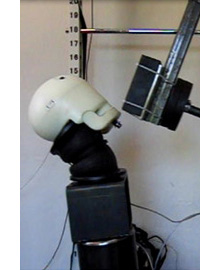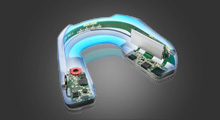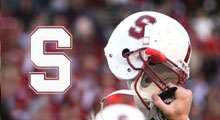A revelation, validated by research.
Understanding impacts to athletes’ heads may assist in the prevention and diagnosis of sports brain injury and return-to-play decisions.
To date, instrumented helmets have been used to estimate head impacts during contact sports. A study by Higgins et al (reference 1) reported that a mouthguard instrumented with linear accelerometers produced an accurate measurement of peak linear acceleration (PLA) and Severity index (SI) of impacts received by a headform while helmet sensors were not as accurate.
This technology is commercially available for the first-time ever with impact sensing-mouthguard and Impact Detection System . A series of tests, including independent research conducted at Stanford School of Medicine, have been conducted to validate the accuracy and viability of the system.
STUDIES AND VALIDATION TESTING
Impact Sensing Mouthguard Validation
In this study we used a mouthguard equipped with linear accelerometers and gyroscopes to measure linear and angular rotational accelerations experienced by the headform, and to validate the use of virtual projection system (VPS) for estimation of accelerations experienced by the brain.
Learn more about the study (PDF )
STANDFORD SCHOOL OF MEDICINE VALIDATION TESTING
Stanford University football players this season are wearing mouthpieces equipped with tiny sensors to measure the force of head impacts during games and practices.
The goal is to help medical scientists better understand what sorts of football collisions cause concussions, as well as whether there are any positions or particular plays associated with a greater risk of these traumatic brain injuries. The mouthpieces contain accelerometers and gyroscopes that measure the linear and rotational force of head impacts.
This study and others will produce a mountain of data to help establish clinically meaningful criteria for diagnosing concussions. “This study will build toward establishing clinically relevant head-impact correlations and thresholds to allow for a better understanding of the biomechanics of brain injuries,” said Dan Garza, MD, an assistant professor of orthopaedic surgery at the Stanford School of Medicine, who is leading the investigation.
Learn more >
References:
1. Higgins M, Halstead PD, Snyder-Mackler L, Barlow D. Measurement of impact acceleration: mouthpiece accelerometer versus helmet accelerometer. J Athl Train. Jan-Mar 2007;42(1):5-10.

Validation testing.
Extensive tests validate the data measured by the Impact Detection System.
Helmet sensors versus mouthguards.
A side-by-side comparison in a study published in the Journal of Athletic Training

Keep in touch.
Find us on Facebook for the latest updates and news about all of our products.

High-tech electronics.
The Impact Sensing Mouthguard accurately measures impacts and accelerations.

Stanford University.
The Stanford University football team is testing the Impact Detection System.

Make an impact.
Join the fight - sponsor a team and help keep concussions out of the game.